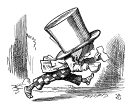Search us!
Search The Word Detective and our family of websites:
This is the easiest way to find a column on a particular word or phrase.
To search for a specific phrase, put it between quotation marks. (note: JavaScript must be turned on in your browser to view results.)
Ask a Question! Puzzled by Posh?
Confounded by Cattycorner?
Baffled by Balderdash?
Flummoxed by Flabbergast?
Perplexed by Pandemonium?
Nonplussed by... Nonplussed?
Annoyed by Alliteration?

Don't be shy!
Send in your question!
Columns from 1995 to 2006 are slowly being added to the above archives. For the moment, they can best be found by using the Search box at the top of this column.
 If you would like to be notified when each monthly update is posted here, sign up for our free email notification list.
If you would like to be notified when each monthly update is posted here, sign up for our free email notification list.
Trivia
All contents herein (except the illustrations, which are in the public domain) are Copyright © 1995-2020 Evan Morris & Kathy Wollard. Reproduction without written permission is prohibited, with the exception that teachers in public schools may duplicate and distribute the material here for classroom use.
Any typos found are yours to keep.
And remember, kids,
Semper Ubi Sub Ubi
|
 readme: readme:
Hey, you know what’s fun? As you page through this site, try to discern the logical connection between the subject matter of the columns and the little ads at the end of each one (and the large ad in the left column too, actually). There almost always is one, but it can be fairly surreal. My use of the word “constructions” in a column, for instance, apparently prompts ads for Carhartt work clothes.
Onward. It occurred to me the other day that it has been almost four years since I switched from Windows XP to Ubuntu Linux. What brought this to mind was this article in the New York Times last week, which is a decent overview of Ubuntu and its founder, Mark Shuttleworth. Not to quibble, but the Times writer, as is drearily the norm in the mass media, filled his article with not-so-subtle signals that you really don’t wanna stand too close to this weirdo operating system.
But Ubuntu is not, as the Times writer says, “relatively easy to use for the technologically savvy.” It’s incredibly easy to use for just about anybody, period. I do my work on two very old computers (2004 vintage low-end Dells, which I got four years ago for less than $300 apiece on eBay). One of them is set up to dual-boot, giving me a choice between Ubuntu or Windows XP Professional when I turn on the machine. (I need XP to run various dictionary CDs.) Every time I have occasion to boot into Windows, I remember why I dumped it. The dorky, inconsistent interface. The weird delays, freezes and crashes for no reason. The endless emergency updates, invariably futile attempts to plug the latest hole discovered in the sieve that is Windows “security.” The choice between being vulnerable to trojans and viruses and running buggy, bloated anti-virus software that slows your computer more than a virus would (a choice I dodge by not allowing Windows to connect to the internet except to get updates). Running the same computer under Windows and Ubuntu is a real eye-opener. Under Ubuntu it runs faster, feels far more stable, and has never, in four years, frozen or crashed.
I can honestly say that I have never, not for a moment, regretted switching to Linux. And in four years I haven’t paid a dime for software. Firefox, Thunderbird mail, Open Office and all the other apps that come built into Ubuntu are better than their Microsoft equivalents, in the case of Firefox far better. There is no need to run an antivirus program. Updates are automatic and drama-free. Best of all, it really does just work, and I never think about it, which is how a computer is supposed to work, right?
Continue reading this post » » »
Perhaps we can bum a light from Piggy.
Dear Word Detective: While watching my granddaughter play at a playground, a lady’s children said that they were building a campfire. I mentioned (jokingly) that I hope that they didn’t have any matches and would start the playground equipment on fire. She replied that her kids called them “fire sticks.” After some thought, I decided that their description was better than mine. So, why are matches called “matches”? My dictionary, besides describing them, indicates that “match” is of French origin and has a date of 1549.– Paul Schmid.
“Fire sticks”? Oh my. Perhaps I’m being an alarmist, but it sounds as if that mother has mistaken “Lord of the Flies” for a child-rearing guide. Or maybe she chose it on purpose. Lately I’ve been wondering if my life hasn’t been one long misunderstanding of the role of dystopian literature (e.g., “Animal Farm,” “Brave New World” and “1984”). I had always presumed that the whole point was to recognize and avoid that sort of thing, but apparently not.
Anyway, I suppose “fire stick” is a good name for matches, just as “horseless carriage” and “iron bird” work pretty well, but I’d argue that particular names for things, even if slightly mysterious, have their own charm. Then again, I remember antimacassars.
The first question that is likely to occur to anyone pondering the roots of “match” is whether the word in the “stick of wood (or paper) tipped with a flammable substance used to start fires” is in any way related to “match” in the “thing that fits or goes well with another thing” or “person some website says I should marry” sense. The answer, fortunately (speaking as the one who would have to explain any such connection) is no.
The “good fit” or “one of a pair” kind of “match” comes from the Old English “gemaecca,” meaning “mate or companion,” and originally meant one’s husband or wife. By about 1300, “match” meant “a person or thing able to compete with another as an equal,” a sense still found in “tennis match” and similar uses. Gradually, however, the aspect of “equal” or “good fit” overshadowed the “contention” sense, which is why “match.com” is not a boxing website.
“Match” in the “fire stick” sense comes from an entirely different root, in this case the Old French “mece,” meaning “candle wick.” Interestingly, the Old French “mece” seems to be rooted in the Greek “myxa,” which meant “wick” but also, originally, “mucus.” The connection was a likening of the wick dangling from an old-fashioned oil lamp to mucus dropping from a person’s runny nose. Though matches today are made of wood or paper, originally lamps, fires, etc. were lit with matches consisting of cord or string soaked in sulfur, making the linguistic connection to the “wick” of a candle logical.
Cat with a hat.
Dear Word Detective: I have two questions for you to answer. One, what the heck is a “fedora,” and two, where does it come from? Also (yes, I know that this is more than two) how do you take one off? Is it like a hat? — Aife N.
Well, to answer your, ahem, fourth question first, yes, it’s like a hat. In fact, a “fedora” is a type of hat, usually worn by men, made of soft felt and having a center crease in the crown and a wide brim. I suspect that your interest in “fedora” may have been piqued by the recent release of the mega-ballyhooed fourth installment in the Indiana Jones adventure series, in all episodes of which Harrison Ford wears a fedora. Personally, I’ll always associate fedoras with Humphrey Bogart playing Sam Spade (or Rick in “Casablanca”). It’s funny you should ask about how to take one off, because there actually is an approved protocol for removing a fedora. It should be grasped by the top of the crown, never by its brim, and lifted gently off the noggin.
I noted above that fedoras are “usually worn by men,” but while the style has long been a symbol of rugged sophistication when worn by men in movies, the original fedora was, in fact, worn by a woman.
“Fedora” is actually the name of a play by the French dramatist Victorien Sardou (1831-1908) that premiered in 1882, written expressly for and starring the legendary Sarah Bernhardt. In the play Bernhardt portrayed Fedora Romanoff, a Russian princess, and wore a hat resembling the modern fedora. The name “Fedora” itself is the feminine form of the Russian “Fedor,” related to the Greek “Theodoros,” meaning “gift of god” (and from which we derive the familiar “Theodore”).
In the early 1920s, the fashion for the “fedora” took off (although primarily among men, not women), and the fedora became the most popular hat style in Europe and North America throughout the first half of the 20th century. When styles changed in the early 1960s and many men quit wearing hats as part of their business attire, the fedora went into eclipse. Indiana Jones notwithstanding, the fedora is probably fated to remain the fusty province of traditionalists in a world dominated by the ubiquitous baseball cap.
Interestingly, the fedora is not the only hat to be launched into fame from the theatrical stage. One of the most popular novels of the late 19th century was George du Maurier’s “Trilby,” the eponymous tale of an gullible Irish lass living in Paris who falls under the spell of a mysterious and hypnotic older man who makes her a star but eventually steals her soul and seals her doom. The popularity of the book made the name of Trilby’s sinister master, Svengali, synonymous with evil manipulation. But when “Trilby” was mounted as a play in London, the audience noticed that one character was wearing a snazzy hat with a narrow brim, a sort of compact fedora, and the style immediately became known as a “trilby.” Trilbys have been popular ever since (Kojak wore one on TV), and today are regarded as hip headgear by a variety of musicians and actors, including Johnny Depp.
|
Makes a great gift! Click cover for more.  
400+ pages of science questions answered and explained for kids -- and adults!
FROM ALTOIDS TO ZIMA, by Evan Morris
 
|
 readme:
readme:

 can be found
can be found 




Recent Comments